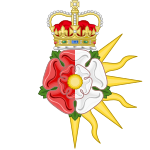 The heraldic badge of Richmond Herald of Arms in Ordinary | |
| Heraldic tradition | Gallo-British |
|---|---|
| Jurisdiction | England, Wales and Northern Ireland |
| Governing body | College of Arms |
Richmond Herald of Arms in Ordinary is an officer of arms of the College of Arms in England. From 1421 to 1485, Richmond was a herald to John of Lancaster, 1st Duke of Bedford, George Plantagenet, 1st Duke of Clarence, and Henry, Earl of Richmond, all of whom held the Honour (estate) of Richmond. However, on the accession of Henry as Henry VII of England in 1485, Richmond became a king of arms and remained so until 1510, when the office became that of a herald in ordinary of the Crown. The badge of office is a red rose of Lancaster dimidiating the white rose en soleil of York, ensigned by the royal crown. Although this device has all the characteristics of a Tudor invention, it is likely to be of fairly recent derivation.
Contents
The office is currently vacant, its last holder having been promoted to Norroy and Ulster King of Arms in 2024.




































